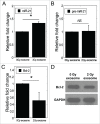Exosome-mediated microRNA transfer plays a role in radiation-induced bystander effect
- PMID: 26488306
- PMCID: PMC4829325
- DOI: 10.1080/15476286.2015.1100795
Exosome-mediated microRNA transfer plays a role in radiation-induced bystander effect
Abstract
Bystander effects can be induced through cellular communication between irradiated cells and non-irradiated cells. The signals that mediate this cellular communication, such as cytokines, reactive oxygen species, nitric oxide and even microRNAs, can be transferred between cells via gap junctions or extracellular medium. We have previously reported that miR-21, a well described DDR (DNA damage response) microRNA, is involved in radiation-induced bystander effects through a medium-mediated way. However, the mechanisms of the microRNA transfer have not been elucidated in details. In the present study, it was found that exosomes isolated from irradiated conditioned medium could induce bystander effects. Furthermore, we demonstrated plenty of evidences that miR-21, which is up-regulated as a result of mimic transfection or irradiation, can be transferred from donor or irradiated cells into extracellular medium and subsequently get access to the recipient or bystander cells through exosomes to induce bystander effects. Inhibiting the miR-21 expression in advance can offset the bystander effects to some extent. From all of these results, it can be concluded that the exosome-mediated microRNA transfer plays an important role in the radiation-induced bystander effects. These findings provide new insights into the functions of microRNAs and the cellular communication between the directly irradiated cells and the non-irradiated cells.
Keywords: bystander effect; exosome; miR-21; microRNA; radiation.
Figures






Similar articles
-
MiR-21 is involved in radiation-induced bystander effects.RNA Biol. 2014;11(9):1161-70. doi: 10.4161/rna.34380. RNA Biol. 2014. PMID: 25483031 Free PMC article.
-
Bystander autophagy mediated by radiation-induced exosomal miR-7-5p in non-targeted human bronchial epithelial cells.Sci Rep. 2016 Jul 15;6:30165. doi: 10.1038/srep30165. Sci Rep. 2016. PMID: 27417393 Free PMC article.
-
The non-targeted effects of radiation are perpetuated by exosomes.Mutat Res. 2015 Feb;772:38-45. doi: 10.1016/j.mrfmmm.2014.12.007. Epub 2014 Dec 30. Mutat Res. 2015. PMID: 25772109
-
Ionizing radiation-induced bystander effects, potential targets for modulation of radiotherapy.Eur J Pharmacol. 2009 Dec 25;625(1-3):156-64. doi: 10.1016/j.ejphar.2009.07.028. Epub 2009 Oct 14. Eur J Pharmacol. 2009. PMID: 19835860 Review.
-
[Radiation-induced bystander effect: the important part of ionizing radiation response. Potential clinical implications].Postepy Hig Med Dosw (Online). 2009 Aug 18;63:377-88. Postepy Hig Med Dosw (Online). 2009. PMID: 19724078 Review. Polish.
Cited by
-
The emerging role of exosomes in radiotherapy.Cell Commun Signal. 2022 Oct 31;20(1):171. doi: 10.1186/s12964-022-00986-1. Cell Commun Signal. 2022. PMID: 36316715 Free PMC article. Review.
-
Harnessing the Angiogenic Potential of Stem Cell-Derived Exosomes for Vascular Regeneration.Stem Cells Int. 2016;2016:3409169. doi: 10.1155/2016/3409169. Epub 2016 Apr 3. Stem Cells Int. 2016. PMID: 27127516 Free PMC article. Review.
-
MicroRNA-21-Enriched Exosomes as Epigenetic Regulators in Melanomagenesis and Melanoma Progression: The Impact of Western Lifestyle Factors.Cancers (Basel). 2020 Jul 29;12(8):2111. doi: 10.3390/cancers12082111. Cancers (Basel). 2020. PMID: 32751207 Free PMC article. Review.
-
Extracellular Vesicles in Modifying the Effects of Ionizing Radiation.Int J Mol Sci. 2019 Nov 6;20(22):5527. doi: 10.3390/ijms20225527. Int J Mol Sci. 2019. PMID: 31698689 Free PMC article. Review.
-
Exosome: A New Player in Translational Nanomedicine.J Clin Med. 2020 Jul 26;9(8):2380. doi: 10.3390/jcm9082380. J Clin Med. 2020. PMID: 32722531 Free PMC article. Review.
References
-
- Banaz-Yasar F, Lennartz K, Winterhager E, Gellhaus A. Radiation-induced bystander effects in malignant trophoblast cells are independent from gap junctional communication. J Cell Biochem 2008; 103:149-61; PMID:17516549 - PubMed
-
- Ryan LA, Smith RW, Seymour CB, Mothersill CE. Dilution of irradiated cell conditioned medium and the bystander effect. Radiation Res 2008; 169:188-96; PMID:18220470 - PubMed
-
- Wang H, Yu KN, Hou J, Liu Q, Han W. Radiation-induced bystander effect: Early process and rapid assessment. Cancer Lett 2013; 356(1):137-44; PMID:24139967 - PubMed
Publication types
MeSH terms
Substances
LinkOut - more resources
Full Text Sources
Other Literature Sources
Miscellaneous
